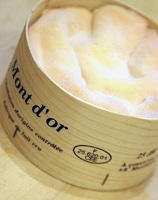A brief guide to French Cheese
 Wednesday, December 16, 2009 at 1:49AM
Wednesday, December 16, 2009 at 1:49AM  I love cheese, and in France there's a lot to love. There are literally hundreds of different cheeses and variations.
I love cheese, and in France there's a lot to love. There are literally hundreds of different cheeses and variations.
As with French wines, there is a system of Appellation d’Origine Contrôlée Laitière (AOC Dairy) which are 42 legally controlled names which can only be used if the maker conforms the requirements of the name. There are even four official kinds of butter and two types of Creme Fraiche. These requirements cover the type of milk used, the texture and the location where the milk is sourced, and the cheese produced. The intention of the AOC name is to protect consumers and producers alike, preventing a cheesemaker in another region (or country) to make a similar cheese sold with that name that may not be of the same quality or flavor. Here you can explore the list of AOC cheeses.
For example, one of my favorites this time of year is Vacherin Mont D'Or. This is defined as a soft washed-rind cows-milk cheese that is produced in selected villages in the Jura Mountains. It is aged in a round box made of Spruce wood that imparts a woody flavor and aroma. Since most cheeses have their seasons, this one is best in the fall. At this point the woody flavor is pronounced, but its still quite creamy. It's especially good with a round Pouligny-Montrachet or an older Mersault. The longer it ages in the Spruce box, the heavier the woody character becomes. Try it at different times of the season to see how you like it best.
My friend L's favorite cheese is Saint-Nectaire. He's from Auvergne and that's the region where this cheese has been made since the 17th century. One of his fondest childhood memories was getting a free morceau of Saint-Nectaire every time he accompagnied his mother to the local fromagèrie. Huh?
When he first told me this story, I had to laugh; finding it hard to imagine a child getting excited about a stinky cheese treat. I don't know about you, but when when I was a kid I remember fondly a getting free cookie at the bakery.
Like much of French food culture, knowing what kind of milk is used and when the season peaks is just the start of understanding cheese. In some cases it helps to know when the milk was produced.
During the brief period L and I lived in London, his parents came from his hometown of Le Puy in Auvergne to visit. They arrived proudly bearing an enormous Saint-Nectaire cheese. "Summer milk" his Mother leaned forward and said to me. She used that same hushed tone some Mothers reserve for words like "Cancer" or "Prison," letting me in on the secret that this was indeed a special cheese. Not only was it L's favorite type of cheese, it was made from Summer milk that imparts a grassier flavor - also his favorite.
It makes sense given that cows are eating grass at that time of the year. It turns out that since Saint-Nectaire is produced throughout the year, there isn't a specific season. The flavor varies along with the taste of the milk used in production. Evidently, a true lover of cheese also knows what time of year each of his favorites is best. The Saint-Necataire made with Summer milk contrasts to one made of Winter milk when the cows are eating silage. If you are like me and have never heard of silage, as best as I can tell silage is a sort of fermented feed that is stored for later use and imparts a stronger flavor.
Try the Saint-nectaire at different times of year to see what you prefer.
Or you can take an armchair trip to Auvergne to learn about Saint-Nectaire first hand.
Your turn to share; What's your favorite childhood food memory?
 Cheese,
Cheese,  L in
L in  Food,
Food,  French Culture
French Culture 

Reader Comments (4)
This makes my mouth water! I can't wait to visit some fromageries next time I am in France.
I COME FROM SOUTH AMERICA AND MY HOMETOWN HAD A "CONFITERIA" WHERE THEY MADE THE DREAMIEST LANGUES DE CHAT. I'VE BEEN TO PARIS SEVERAL TIMES AND TRIED MANY OF THEIR LANGUES DE CHAT. THEY HAVE YET TO FIND THE RECIPE USED BY CONFITERIA VERTUA. I KNOW THAT PROUST WOULD BE AGREENG WITH ME WHEN HE ATE HIS MADELEINES AS A CHILD!
Hi Maria,
Les Langues de Chat are indeed delicous when made well. One similar choice for you to try that might live up to those you ate growing up are called Punitions - "Punishments." You can find them at the Poilâne Bakery on rue Cherche-Midi in the 6th Arrondisement.
Insipired by the sablé cookies made by the Grandmother of the late owner, Lionel Poilâne, he called them punishments because they were so good you couldn't stop eating them. I certainly can't.
http://www.poilane.fr/
Cannot wait to be punished at Poilane's. Thank you so much for the suggestion and for all the information!